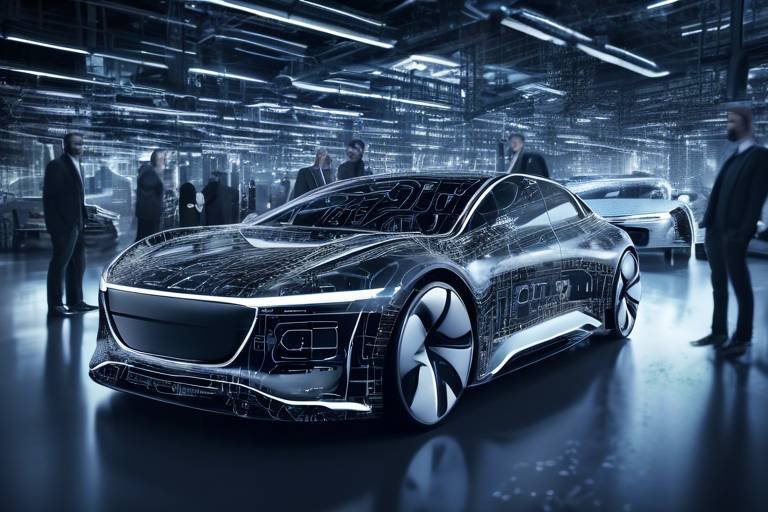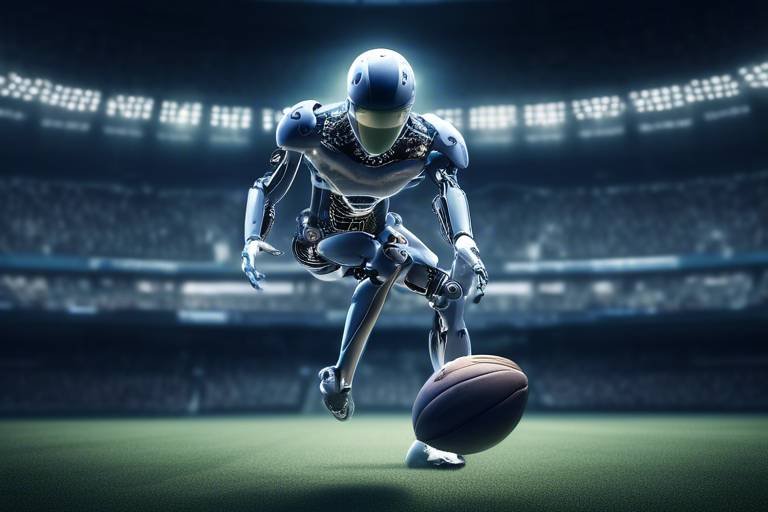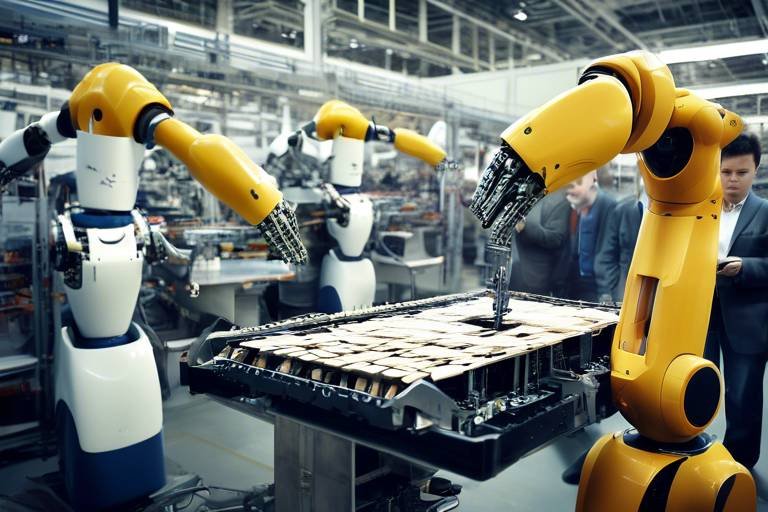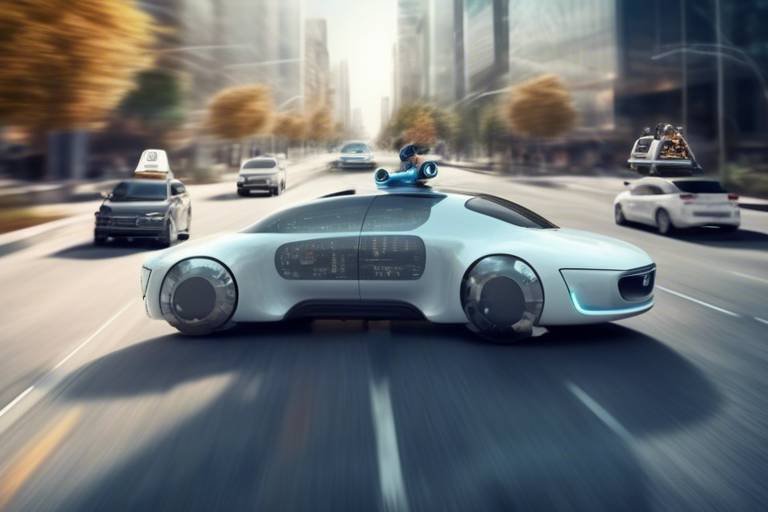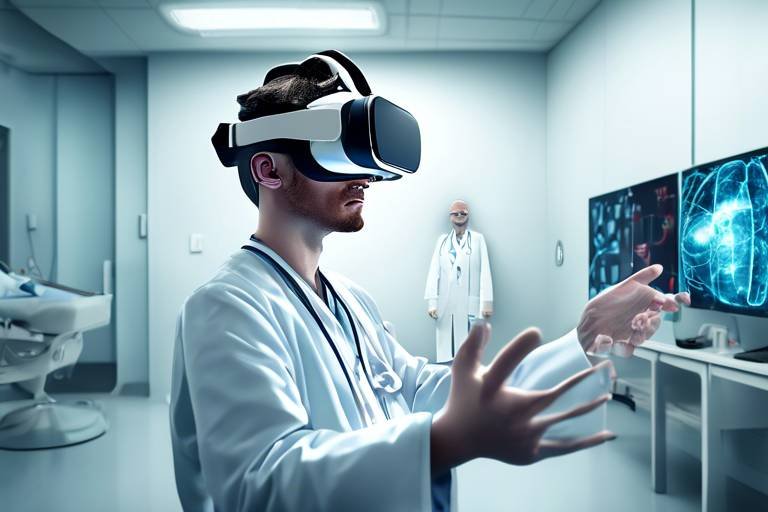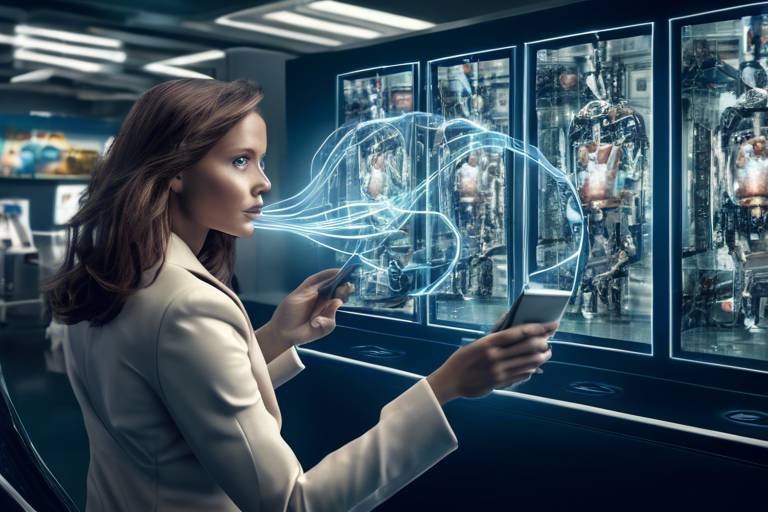How AI is Transforming the Automotive Industry?
The automotive industry is undergoing a remarkable transformation, thanks to the advent of artificial intelligence (AI). Imagine a world where cars are not just machines but intelligent entities capable of making decisions, learning from experiences, and enhancing our driving experiences. This is not some distant future; it's happening right now! AI is reshaping every aspect of the automotive sector, from the way vehicles are manufactured to how we interact with them on the road. But how exactly is AI making such a significant impact? Let's dive in and explore the various ways AI is revolutionizing the automotive landscape.
When it comes to vehicle manufacturing, AI technologies are like a breath of fresh air, optimizing production lines, reducing waste, and improving quality control. Imagine a factory where robots work alongside humans, analyzing data in real-time to streamline processes. This is the reality of modern vehicle manufacturing. With AI, manufacturers can predict potential bottlenecks, adjust workflows, and enhance overall efficiency. For instance, AI algorithms can analyze historical production data to identify patterns and suggest improvements, ultimately leading to cost-effectiveness and higher-quality products.
One of the most exciting advancements in the automotive industry is the rise of autonomous vehicles. These self-driving cars represent a leap forward in technology, enabling vehicles to navigate complex environments with minimal human intervention. But how does AI make this possible? Through a combination of advanced algorithms and data processing, AI allows cars to understand their surroundings, make decisions, and drive safely. The implications for road safety and efficiency are profound, offering the potential to reduce accidents and traffic congestion.
The backbone of autonomous vehicles lies in their sensor technology. These vehicles are equipped with an array of sensors that gather data about their environment. AI plays a crucial role in processing this data, enabling real-time driving decisions. For instance, when a car encounters a pedestrian or an obstacle, AI quickly analyzes the information from various sensors to determine the best course of action. This capability is essential for ensuring safety on the roads, as it allows vehicles to react swiftly to changing conditions.
Among the various sensors, LiDAR and radar systems are particularly vital for detecting obstacles and mapping surroundings. LiDAR uses laser beams to create a precise 3D map of the environment, while radar systems provide information about the speed and distance of objects. Together, they enhance a vehicle's perception capabilities, making it possible to identify potential hazards and navigate safely. This technology is a game-changer, as it significantly reduces the risk of accidents caused by human error.
Another critical aspect of autonomous driving is computer vision. This technology enables vehicles to interpret visual data from cameras, helping them recognize traffic signs, lane markings, and other important visual cues. AI-powered computer vision systems improve object recognition and scene understanding, allowing cars to make informed decisions based on their surroundings. For example, when a vehicle approaches a stop sign, the computer vision system identifies it and prompts the car to stop, ensuring compliance with traffic regulations and enhancing safety.
AI's contribution to vehicle safety features cannot be overstated. By analyzing vast amounts of data from various sources, AI algorithms can predict and prevent accidents before they occur. This predictive capability is a game-changer for both drivers and passengers, as it enhances overall safety on the roads. For instance, AI can analyze driving patterns and identify risky behaviors, prompting interventions to prevent potential accidents. The integration of AI in safety systems is paving the way for a future where our roads are safer and more secure.
As vehicles become more connected, infotainment systems are evolving to be smarter and more intuitive. AI integration allows these systems to personalize user experiences, offering tailored content and improved connectivity. Imagine getting into your car, and it already knows your favorite playlist, preferred routes, and even your schedule for the day. This level of personalization is made possible through AI algorithms that learn from user interactions and preferences.
One of the most exciting advancements in infotainment systems is voice recognition technology. This technology is transforming how drivers interact with their vehicles, making it easier and safer to access information while on the road. With advancements in natural language processing, drivers can now use voice commands to control navigation, adjust settings, and even make phone calls. This hands-free interaction not only enhances user convenience but also promotes safety by minimizing distractions.
Another remarkable application of AI in the automotive sector is predictive maintenance. By analyzing data from various sensors and vehicle performance metrics, AI can anticipate potential issues before they arise. This proactive approach helps prolong vehicle lifespan and reduce repair costs, saving drivers both time and money. Instead of waiting for a warning light to appear on the dashboard, drivers can receive alerts about maintenance needs in advance, ensuring their vehicles remain in optimal condition.
- What is AI's role in autonomous vehicles? AI processes data from sensors to enable self-driving cars to navigate safely and efficiently.
- How does AI improve vehicle manufacturing? AI optimizes production lines, reduces waste, and enhances quality control in vehicle manufacturing.
- What are the benefits of predictive maintenance? Predictive maintenance helps anticipate vehicle issues, prolongs lifespan, and reduces repair costs.
- How does voice recognition technology enhance driver safety? It allows drivers to interact with their vehicles hands-free, minimizing distractions while driving.

AI in Vehicle Manufacturing
Artificial Intelligence (AI) is not just a buzzword; it's a game changer in the automotive manufacturing landscape. Imagine a production line where every component is meticulously crafted with minimal waste and maximum efficiency. That's the reality today, thanks to AI technologies that are streamlining manufacturing processes. By leveraging advanced algorithms and machine learning, manufacturers can analyze vast amounts of data to optimize every aspect of production. This means not only faster assembly times but also improved quality control, ensuring that each vehicle that rolls off the line meets the highest standards.
One of the most significant impacts of AI in vehicle manufacturing is its ability to predict equipment failures before they happen. This predictive maintenance capability saves companies both time and money. For instance, by analyzing data from machinery sensors, AI can identify patterns that indicate when a machine is likely to fail. As a result, manufacturers can schedule maintenance during non-peak hours, minimizing downtime and keeping production flowing smoothly.
Furthermore, AI is revolutionizing the way manufacturers approach supply chain management. With the ability to analyze market trends, consumer demands, and supplier performance, AI helps companies make informed decisions about inventory and procurement. This not only reduces costs but also ensures that manufacturers can respond swiftly to changes in demand. Imagine having the ability to adjust production schedules on the fly, based on real-time data—this is the power of AI!
To give you a clearer picture, here’s a table summarizing the key benefits of AI in vehicle manufacturing:
| Benefit | Description |
|---|---|
| Increased Efficiency | AI optimizes production lines, reducing cycle times and improving output. |
| Cost Reduction | By minimizing waste and enhancing supply chain management, AI significantly lowers costs. |
| Quality Control | AI systems monitor production quality in real-time, ensuring high standards. |
| Predictive Maintenance | AI anticipates equipment failures, allowing for proactive maintenance and reduced downtime. |
Additionally, AI is enhancing collaboration within manufacturing teams. With AI-driven platforms, engineers and designers can share insights and data seamlessly, fostering a culture of innovation. This collaborative environment not only speeds up the design process but also leads to smarter, more efficient vehicles. Think of it as a symphony where every instrument plays in harmony, creating a masterpiece that is not only functional but also aesthetically pleasing.
In conclusion, the integration of AI in vehicle manufacturing is paving the way for a smarter, more efficient industry. As these technologies continue to evolve, we can only expect even greater advancements that will revolutionize how vehicles are produced. So, the next time you see a sleek new car on the road, remember that behind the scenes, AI is working tirelessly to make it a reality.

Autonomous Vehicles
Autonomous vehicles are not just a futuristic dream; they are rapidly becoming a reality, reshaping the very fabric of our transportation systems. Imagine a world where you can sit back, relax, and let your car do the driving while you catch up on your favorite show or read a book. Sounds incredible, right? Well, that’s the essence of what AI is bringing to the table in the automotive industry. By leveraging artificial intelligence, these vehicles are equipped to handle complex environments, making driving safer and more efficient.
At the heart of autonomous vehicles lies a sophisticated system of algorithms and sensors that work in harmony to interpret the world around them. Think of it as giving the car a set of eyes and a brain to navigate through traffic, detect pedestrians, and respond to changing road conditions. This level of automation relies heavily on AI technologies that analyze vast amounts of data in real-time, allowing for quick decision-making that enhances both safety and comfort on the road.
One of the most fascinating aspects of autonomous vehicles is their ability to process information from various sensor technologies. These sensors can include cameras, LiDAR, and radar systems, each contributing to a comprehensive understanding of the vehicle’s surroundings. For instance, while cameras capture visual data, LiDAR and radar provide depth perception and obstacle detection. Together, they create a 360-degree view that is critical for safe navigation.
The integration of advanced sensors is crucial for autonomous vehicles. These sensors gather data about the vehicle's environment, which AI algorithms then process to make real-time driving decisions. The ability to interpret this data accurately is what sets autonomous vehicles apart from traditional cars. Imagine trying to navigate a busy city street without being able to see or understand your surroundings—it's nearly impossible! However, with the right sensor technology, autonomous vehicles can "see" and "understand" their environment with remarkable precision.
LiDAR (Light Detection and Ranging) and radar systems are essential components in the arsenal of sensor technologies used in autonomous vehicles. LiDAR uses laser beams to measure distances, creating a detailed 3D map of the environment. This technology is particularly effective in detecting obstacles, even in low-light conditions. On the other hand, radar systems excel at measuring the speed and distance of objects, making them invaluable for tracking moving vehicles. Together, they enhance vehicle perception and safety, ensuring that autonomous cars can navigate through complex scenarios without a hitch.
Computer vision is the brain behind the eyes of autonomous vehicles. This technology allows cars to interpret visual data from cameras and make sense of the world around them. By employing advanced algorithms, computer vision systems improve object recognition, enabling the vehicle to identify pedestrians, traffic signals, and other critical elements on the road. Just like humans rely on their vision to make split-second decisions, autonomous vehicles use computer vision to assess situations and react accordingly. This capability is crucial for ensuring the safety of passengers and pedestrians alike.
In summary, the integration of AI in autonomous vehicles is a game-changer for the automotive industry. As these technologies continue to evolve, the dream of fully autonomous driving is inching closer to reality. The combination of sophisticated sensor technology and advanced AI algorithms is paving the way for a safer, more efficient transportation future.
- What are autonomous vehicles? Autonomous vehicles are cars that can drive themselves without human intervention, using AI and sensor technologies to navigate safely.
- How do autonomous vehicles ensure safety? They use advanced sensors and AI algorithms to detect obstacles, interpret road signs, and make real-time driving decisions.
- What role does AI play in autonomous driving? AI processes data from various sensors, enabling the vehicle to understand its environment and react appropriately.
- Are autonomous vehicles already on the road? Yes, various companies are testing autonomous vehicles in real-world conditions, and some are already being used in limited capacities.

Sensor Technology
When we think about the magic of autonomous vehicles, one of the first things that comes to mind is the incredible that powers these modern marvels. Imagine driving down a busy street, and your car is not just following the road but actively analyzing its surroundings in real-time. That’s what AI-driven sensors do—they provide a comprehensive view of the environment, allowing the vehicle to make split-second decisions. This technology is akin to giving a car a set of eyes, ears, and a brain all at once!
At the heart of this technology are various types of sensors, each playing a unique role in ensuring the vehicle's safety and efficiency. For instance, LiDAR and radar systems are crucial for detecting obstacles, while cameras contribute to understanding visual cues. These sensors work in harmony, creating a 360-degree perception of the vehicle's surroundings. It’s like having a superhero sidekick that warns you of impending dangers before you even notice them!
To dive deeper, let’s break down the types of sensors commonly used in autonomous vehicles:
- LiDAR (Light Detection and Ranging): This technology uses laser light to measure distances and create a high-resolution 3D map of the environment. It’s particularly effective in identifying objects and their proximity.
- Radar: Utilizing radio waves, radar systems are excellent for detecting the speed and direction of moving objects, making them indispensable for adaptive cruise control and collision avoidance.
- Cameras: Cameras provide visual data that is processed by AI algorithms to recognize traffic signs, lane markings, and pedestrians. They are essential for interpreting complex driving scenarios.
Each of these sensors contributes to a robust data ecosystem that the AI uses to make informed decisions. For instance, if a pedestrian suddenly steps onto the road, the LiDAR detects the obstacle, the radar assesses its speed, and the camera captures its movement. All this information is processed in milliseconds, allowing the vehicle to react appropriately—whether that means slowing down or stopping entirely. This level of real-time analysis is what sets autonomous vehicles apart from traditional ones.
Furthermore, the integration of these sensors is not just about immediate safety; it’s also about creating a seamless driving experience. By continuously gathering data, these systems learn and adapt, improving their responses over time. It’s like teaching a child to ride a bike—initially, they might wobble, but with practice, they become more confident and skilled. Similarly, as autonomous vehicles gather more data, their ability to navigate complex environments becomes increasingly refined.
In conclusion, sensor technology is the backbone of the autonomous vehicle revolution. It empowers cars to see, understand, and react to their surroundings with a level of precision that was once the stuff of science fiction. As AI continues to evolve, we can only imagine the heights this technology will reach, transforming our roads into safer, smarter environments.
- What types of sensors are used in autonomous vehicles? Autonomous vehicles typically use LiDAR, radar, and cameras to gather data about their surroundings.
- How does AI process sensor data? AI algorithms analyze data from multiple sensors in real-time to make informed driving decisions, ensuring safety and efficiency.
- Can autonomous vehicles operate in all weather conditions? While technology is improving, adverse weather conditions can still pose challenges for sensor performance, particularly for cameras and LiDAR.

LiDAR and Radar Systems
When it comes to the world of autonomous vehicles, LiDAR and radar systems are like the eyes and ears of a self-driving car. Imagine trying to navigate through a bustling city without being able to see or hear anything; that's how crucial these technologies are for vehicles that operate without human intervention. Both LiDAR and radar provide essential data that helps vehicles understand their surroundings, making real-time decisions that ensure safety and efficiency.
LiDAR, which stands for Light Detection and Ranging, uses laser beams to measure distances. It creates a detailed 3D map of the environment, allowing the vehicle to detect obstacles, lane markings, and even pedestrians with remarkable accuracy. On the other hand, radar systems utilize radio waves to detect objects and their speed. While LiDAR provides high-resolution images of the environment, radar excels in detecting objects in poor weather conditions, such as fog or heavy rain. Together, these technologies complement each other, offering a comprehensive understanding of the vehicle's surroundings.
To illustrate how these systems work together, consider the following comparison:
| Feature | LiDAR | Radar |
|---|---|---|
| Technology | Laser beams | Radio waves |
| Range | Up to 200 meters | Up to 300 meters |
| Resolution | High | Medium |
| Weather Performance | Poor in fog/rain | Good in fog/rain |
This table highlights how LiDAR and radar systems play distinct yet complementary roles in enhancing the perception capabilities of autonomous vehicles. By leveraging both technologies, manufacturers can create vehicles that are not only intelligent but also safe to operate in varied conditions.
Moreover, the integration of these systems into the vehicle's decision-making algorithms is a game-changer. When a self-driving car encounters a situation, such as a child suddenly running into the street, the LiDAR system detects the child’s position, while the radar can gauge the speed of nearby vehicles. This real-time data processing allows the car to make split-second decisions, whether it’s to apply the brakes or swerve to avoid an accident.
In conclusion, LiDAR and radar systems are indispensable components of the autonomous driving landscape. Without them, self-driving cars would be navigating blind, unable to interpret the complexities of our world. As technology continues to evolve, we can expect these systems to become even more sophisticated, paving the way for safer and more efficient autonomous driving experiences.
- What is LiDAR technology? LiDAR stands for Light Detection and Ranging, and it uses laser beams to create detailed 3D maps of the environment.
- How does radar work in autonomous vehicles? Radar systems use radio waves to detect objects and measure their speed, even in poor weather conditions.
- Why are both LiDAR and radar important? They provide complementary data that enhances the vehicle's ability to perceive its surroundings, ensuring safer navigation.
- Can LiDAR work in bad weather? LiDAR performance can be significantly affected by fog, rain, or snow, whereas radar performs well in such conditions.

Computer Vision
In the rapidly evolving landscape of autonomous vehicles, stands out as a fundamental technology that enables these vehicles to interpret and understand their surroundings. Imagine driving through a bustling city, where every pedestrian, cyclist, and vehicle is a potential hazard. How does a self-driving car navigate this chaos? The answer lies in sophisticated computer vision systems powered by artificial intelligence.
Computer vision allows vehicles to process visual data captured by cameras installed around the car. These systems use machine learning algorithms to analyze images and videos, enabling the vehicle to recognize objects, track movements, and even predict actions. For instance, when a child unexpectedly runs into the street, the car's computer vision system can detect the child, assess the situation, and make split-second decisions to avoid an accident. This level of responsiveness is crucial for ensuring safety on the roads.
Furthermore, the integration of computer vision with other technologies, such as LiDAR and radar, creates a comprehensive understanding of the vehicle's environment. While LiDAR provides precise distance measurements, computer vision adds depth by interpreting the visual context of the scene. Together, they form a robust perception system that enhances the vehicle's ability to navigate complex environments.
Here are some key capabilities of computer vision in autonomous vehicles:
- Object Detection: Identifying and classifying objects such as vehicles, pedestrians, and traffic signs.
- Lane Detection: Recognizing lane markings to stay within the designated path.
- Traffic Light Recognition: Understanding traffic signals and responding accordingly.
- Obstacle Avoidance: Detecting potential obstacles and determining safe navigation paths.
As the technology continues to advance, the accuracy and efficiency of computer vision systems are expected to improve significantly. By harnessing vast amounts of data and leveraging powerful algorithms, AI-driven computer vision is transforming the way autonomous vehicles perceive the world, making them safer and more reliable. In essence, computer vision is like giving cars a pair of intelligent eyes, allowing them to see and react to the world around them in real-time.

Safety Enhancements
When it comes to automotive safety, AI is not just a buzzword; it’s a game-changer. Imagine driving down the highway, and your car is not only aware of its surroundings but actively working to keep you safe. That’s the power of AI! By analyzing vast amounts of data in real-time, AI algorithms can predict potential hazards and react faster than any human driver ever could. This capability is akin to having a super-intelligent co-pilot who never sleeps and is always on alert.
One of the most remarkable aspects of AI in automotive safety is its ability to learn from past incidents. By crunching data from millions of driving scenarios, AI can identify patterns and trends that might lead to accidents. For instance, if certain road conditions consistently lead to collisions, AI can alert drivers to exercise caution in those areas. This proactive approach to safety is like having a weather forecast for driving conditions—helping you stay one step ahead of danger.
Moreover, AI-powered systems are designed to enhance traditional safety features. For example, adaptive cruise control and lane-keeping assist are becoming standard in many vehicles. These systems use AI to monitor traffic patterns and adjust speed accordingly, reducing the likelihood of rear-end collisions. Think of it as your car having a built-in radar system that keeps you safe from unexpected stops or swerves by other vehicles.
To illustrate the impact of AI on vehicle safety, consider the following table that summarizes key AI-driven safety features:
| Safety Feature | Description | AI Contribution |
|---|---|---|
| Automatic Emergency Braking | Stops the vehicle to avoid a collision. | Analyzes distance to obstacles and calculates stopping distance. |
| Blind Spot Detection | Alerts drivers to vehicles in their blind spots. | Processes data from sensors to provide real-time alerts. |
| Collision Avoidance Systems | Helps steer or brake to avoid accidents. | Utilizes machine learning to predict potential collisions. |
| Adaptive Headlights | Adjusts headlight direction based on steering. | Uses AI to enhance visibility in curves and turns. |
These features are just the tip of the iceberg when it comes to what AI can do for automotive safety. The integration of machine learning and advanced algorithms allows for a level of precision and responsiveness that was previously unimaginable. As vehicles become more connected, the potential for AI to enhance safety continues to grow.
In conclusion, the role of AI in enhancing vehicle safety cannot be overstated. It’s not just about adding new features; it’s about fundamentally changing how we think about safety on the road. With AI at the helm, we can look forward to a future where driving is not only more enjoyable but also significantly safer for everyone. So, buckle up and enjoy the ride into this exciting new era of automotive innovation!
- How does AI improve vehicle safety? AI enhances vehicle safety by analyzing real-time data to predict and prevent accidents, enabling features like automatic emergency braking and lane-keeping assist.
- What are some examples of AI safety features in cars? Examples include adaptive cruise control, blind spot detection, and collision avoidance systems, all of which utilize AI to enhance driver awareness and response.
- Will AI replace human drivers? While AI will significantly enhance driving safety and efficiency, the goal is to assist human drivers rather than completely replace them.
- How does AI learn from past accidents? AI systems analyze historical data from various driving scenarios to identify patterns that contribute to accidents, helping to inform future safety measures.

AI-Powered Infotainment Systems
As we delve into the realm of , it’s fascinating to witness how artificial intelligence is not just a buzzword, but a transformative force in our vehicles. Gone are the days when car entertainment systems were merely about playing music or providing basic navigation. Today, these systems are evolving into smart assistants that understand our preferences, anticipate our needs, and enhance our driving experience significantly.
Imagine stepping into your car, and it immediately recognizes you, adjusts the seat to your preferred position, and starts playing your favorite playlist. This is the magic of AI integration in infotainment systems. By leveraging advanced algorithms and machine learning, these systems can analyze your behavior and preferences over time. They learn what you like, when you like it, and even how you like it. The result? A personalized driving experience that feels tailor-made just for you.
One of the standout features of these AI-infused systems is their ability to offer real-time connectivity. With the integration of the Internet of Things (IoT), your vehicle can connect to your smart home devices, allowing you to control your home environment right from your dashboard. Want to adjust the thermostat before you get home? Or maybe turn on the lights? With a simple voice command, your car can handle it all. This level of connectivity not only enhances convenience but also adds a layer of safety, as drivers can stay focused on the road while managing their home.
Speaking of voice commands, voice recognition technology has seen remarkable advancements thanks to AI. The days of struggling to get your car's system to understand you are fading fast. Modern infotainment systems can now process natural language, making it feel like you’re having a conversation with a friend. You can ask for directions, change the music, or even check the weather, all without taking your hands off the wheel. This seamless interaction not only improves user experience but also enhances safety by minimizing distractions.
Moreover, the predictive capabilities of AI in infotainment systems are nothing short of impressive. These systems can analyze your driving patterns and suggest the best routes based on traffic conditions, weather, and even your schedule. Imagine being alerted about a traffic jam ahead and being offered an alternative route before you even realize there’s a problem. This proactive approach not only saves time but also reduces stress, making your journey more enjoyable.
To illustrate the impact of AI on infotainment systems, let’s take a look at a comparison of traditional systems versus AI-powered systems:
| Feature | Traditional Infotainment System | AI-Powered Infotainment System |
|---|---|---|
| User Interaction | Basic voice commands | Natural language processing |
| Personalization | Limited customization | Adapts to user preferences |
| Connectivity | Basic Bluetooth | IoT integration and smart home control |
| Navigation | Static maps | Dynamic route suggestions |
This table highlights just a few of the many ways AI is enhancing the infotainment experience in vehicles. As we continue to embrace these technologies, we can only expect further innovations that will make our driving experiences safer, more enjoyable, and incredibly personalized.
In conclusion, AI-powered infotainment systems are not just a trend; they are the future of driving. With their ability to learn, adapt, and connect, these systems are redefining what it means to be behind the wheel. So, the next time you hop into your car, take a moment to appreciate the incredible technology at your fingertips and how it’s shaping the future of mobility.
- What is an AI-powered infotainment system? - It's a vehicle's entertainment system that uses artificial intelligence to enhance user interaction, personalization, and connectivity.
- How does voice recognition work in these systems? - AI-powered voice recognition systems use natural language processing to understand and respond to user commands more effectively.
- Can these systems connect to my smart home devices? - Yes, many AI-powered infotainment systems can integrate with smart home technology, allowing you to control your home remotely.
- Are AI-powered infotainment systems safer? - Yes, they enhance safety by minimizing distractions through voice commands and providing real-time traffic updates.

Voice Recognition Technology
In today's fast-paced world, is becoming a game-changer in the automotive industry. Imagine cruising down the highway, hands on the wheel, and all you need to do is speak your command to control your vehicle's features. Sounds futuristic, right? But this is the reality that AI is crafting for us. The integration of voice recognition systems in cars is not just about convenience; it’s about enhancing safety and creating a more personalized driving experience.
At its core, voice recognition technology leverages natural language processing (NLP) to understand and respond to human speech. This is a sophisticated blend of linguistics and computer science that allows the vehicle to interpret commands accurately. Whether you want to change the music, get directions, or make a phone call, the vehicle's system can respond to your voice, minimizing distractions and keeping your focus on the road. This is particularly crucial in preventing accidents that can occur when drivers fumble with buttons or touch screens.
Furthermore, advancements in machine learning are helping these systems get smarter over time. As the AI learns from user interactions, it can adapt to individual speech patterns, accents, and preferences, making the driving experience more intuitive. For instance, if you frequently ask for a specific playlist or a particular route to work, the system can anticipate your needs and suggest them without being prompted. This level of personalization not only enhances user satisfaction but also fosters a deeper connection between the driver and their vehicle.
However, there are challenges to overcome. Voice recognition systems must be able to function in noisy environments, such as when the radio is blasting or windows are down. To tackle this, manufacturers are employing advanced algorithms that filter out background noise, ensuring that your commands are heard loud and clear. Additionally, concerns about privacy and data security are paramount. Users are increasingly aware that their voice data may be collected and analyzed, leading to a demand for robust security measures to protect personal information.
To give you a clearer picture, let’s look at some key features of voice recognition technology in vehicles:
| Feature | Description |
|---|---|
| Hands-Free Control | Allows drivers to control navigation, music, and phone calls without taking their hands off the wheel. |
| Personalization | Adapts to individual user preferences, learning commands and routines over time. |
| Noise Cancellation | Utilizes advanced algorithms to filter background noise, ensuring accurate command recognition. |
| Enhanced Safety | Reduces distractions, allowing drivers to keep their focus on the road. |
As we look ahead, the future of voice recognition technology in vehicles is incredibly promising. With continuous improvements in AI and machine learning, we can expect even more sophisticated systems that will not only enhance our driving experience but also contribute to safer roads. It’s an exciting time for automotive innovation, and voice recognition is just one of the many ways AI is transforming how we interact with our vehicles.
- How does voice recognition technology work in cars? It uses natural language processing to interpret and respond to spoken commands.
- Can voice recognition systems understand different accents? Yes, modern systems are designed to learn and adapt to various speech patterns and accents.
- Is my voice data secure when using these systems? Most manufacturers implement strong security measures, but it's always good to check their privacy policies.
- What happens if the system misinterprets my command? Many systems allow for corrections and clarifications to ensure accurate responses.

Predictive Maintenance
Predictive maintenance is a game-changer in the automotive industry, leveraging the power of artificial intelligence to foresee potential vehicle issues before they escalate into costly repairs. Imagine driving a car that not only tells you when it needs an oil change but also predicts when the brakes might wear out or when the battery is likely to fail. This proactive approach not only enhances vehicle longevity but also saves you money and minimizes the risk of breakdowns.
At the heart of predictive maintenance lies data analysis. Vehicles today are equipped with a plethora of sensors that continuously monitor various components. These sensors collect data on everything from engine temperature to tire pressure. AI algorithms then analyze this data, looking for patterns and anomalies that could indicate an impending failure. For instance, if the data shows that the engine is running hotter than usual, the system can alert the driver to check the cooling system before it leads to a breakdown.
One of the most exciting aspects of predictive maintenance is its ability to tailor maintenance schedules based on actual vehicle usage rather than relying on generic timelines. Traditional maintenance schedules often suggest service at fixed intervals, regardless of how the vehicle is driven. With AI, maintenance can be customized, ensuring that the vehicle receives attention when it truly needs it. This not only optimizes performance but also extends the lifespan of crucial components.
To illustrate the benefits of predictive maintenance, consider the following table that outlines some key advantages:
| Advantage | Description |
|---|---|
| Cost Savings | Reduces repair costs by addressing issues before they become major problems. |
| Increased Safety | Minimizes the risk of breakdowns and accidents by ensuring the vehicle is in optimal condition. |
| Improved Performance | Maintains peak vehicle performance through timely interventions. |
| Enhanced Longevity | Extends the lifespan of vehicle components through proactive care. |
In addition to enhancing safety and performance, predictive maintenance also contributes to sustainability. By ensuring that vehicles are running efficiently, it helps in reducing emissions and fuel consumption. This is particularly important in today's world where environmental concerns are at the forefront. The less frequently a vehicle needs repairs or replacements, the less waste is produced, which is a win-win for both the owner and the planet.
As we move towards a future where AI becomes increasingly integrated into our daily lives, the role of predictive maintenance in the automotive industry will only grow. It represents a shift from reactive to proactive vehicle care, fundamentally changing how we think about maintenance. So, next time you hop into your car, remember that AI is not just about self-driving technology; it's also about keeping your ride in top shape, making your driving experience safer and more enjoyable.
- What is predictive maintenance?
Predictive maintenance uses AI and data analytics to anticipate vehicle issues before they occur, allowing for timely repairs and maintenance. - How does predictive maintenance save money?
By identifying potential problems early, it prevents costly repairs and minimizes downtime, ultimately saving you money. - Can predictive maintenance extend the life of my vehicle?
Yes, by ensuring that maintenance is performed only when necessary, predictive maintenance helps extend the lifespan of vehicle components. - Is predictive maintenance available for all vehicles?
While many modern vehicles are equipped with the necessary sensors and technology, the availability of predictive maintenance may vary based on the make and model.
Frequently Asked Questions
- What role does AI play in vehicle manufacturing?
AI is revolutionizing vehicle manufacturing by optimizing production lines, reducing waste, and enhancing quality control. With AI-driven analytics, manufacturers can streamline their processes, resulting in greater efficiency and cost savings.
- How do autonomous vehicles navigate complex environments?
Autonomous vehicles utilize a combination of advanced sensors, including LiDAR and radar, along with AI algorithms that process this data in real-time. This allows them to make informed driving decisions, ensuring safety and efficiency on the roads.
- What is the significance of sensor technology in self-driving cars?
Sensor technology is crucial for autonomous vehicles as it helps detect obstacles and map surroundings. AI processes the information gathered from these sensors, enabling the vehicle to react appropriately to its environment.
- How does computer vision improve vehicle safety?
Computer vision systems powered by AI enhance object recognition and scene understanding, allowing vehicles to identify potential hazards more effectively. This technology plays a vital role in preventing accidents and improving overall safety.
- What safety features are enhanced by AI?
AI significantly contributes to vehicle safety by analyzing data to predict and prevent accidents. Features such as automatic emergency braking and lane-keeping assistance are examples of how AI enhances driver and passenger safety.
- How are AI-powered infotainment systems changing user experiences?
AI integration in infotainment systems personalizes user experiences by offering tailored content and improved connectivity. This means drivers can enjoy a more intuitive and engaging interaction with their vehicles.
- What advancements have been made in voice recognition technology?
Voice recognition technology has seen significant improvements through advancements in natural language processing. This allows drivers to interact with their vehicles more conveniently and safely, minimizing distractions while driving.
- How does predictive maintenance work with AI?
Predictive maintenance leverages AI to analyze data and anticipate vehicle issues before they arise. This proactive approach helps prolong the lifespan of vehicles and reduces repair costs by addressing potential problems early on.

